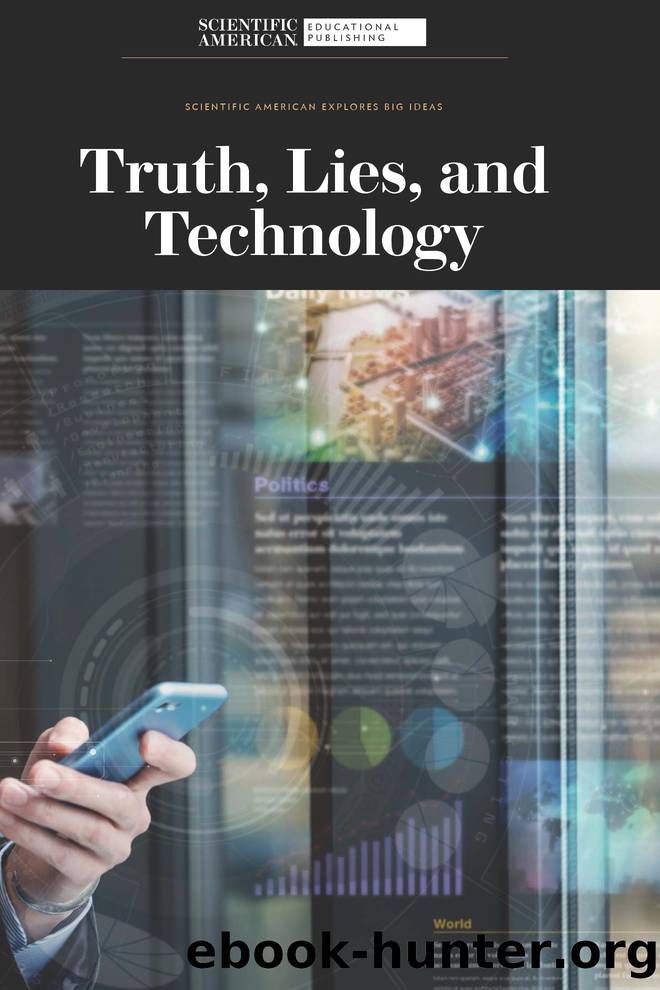Truth, Lies, and Technology by Scientific American Editors

Author:Scientific American Editors
Language: eng
Format: epub
Publisher: The Rosen Publishing Group, Inc
Information Overload Helps Fake News Spread, and Social Media Knows It
By Filippo Menczer, Thomas Hills
Consider Andy, who is worried about contracting COVID-19. Unable to read all the articles he sees on it, he relies on trusted friends for tips. When one opines on Facebook that pandemic fears are overblown, Andy dismisses the idea at first. But then the hotel where he works closes its doors, and with his job at risk, Andy starts wondering how serious the threat from the new virus really is. No one he knows has died, after all. A colleague posts an article about the COVID âscareâ having been created by Big Pharma in collusion with corrupt politicians, which jibes with Andyâs distrust of government. His web search quickly takes him to articles claiming that COVID-19 is no worse than the flu. Andy joins an online group of people who have been or fear being laid off and soon finds himself asking, like many of them, âWhat pandemic?â When he learns that several of his new friends are planning to attend a rally demanding an end to lockdowns, he decides to join them. Almost no one at the massive protest, including him, wears a mask. When his sister asks about the rally, Andy shares the conviction that has now become part of his identity: COVID is a hoax.
This example illustrates a minefield of cognitive biases. We prefer information from people we trust, our in-group. We pay attention to and are more likely to share information about risksâfor Andy, the risk of losing his job. We search for and remember things that fit well with what we already know and understand. These biases are products of our evolutionary past, and for tens of thousands of years, they served us well. People who behaved in accordance with themâfor example, by staying away from the overgrown pond bank where someone said there was a viperâwere more likely to survive than those who did not.
Modern technologies are amplifying these biases in harmful ways, however. Search engines direct Andy to sites that inflame his suspicions, and social media connects him with like-minded people, feeding his fears. Making matters worse, botsâautomated social media accounts that impersonate humansâenable misguided or malevolent actors to take advantage of his vulnerabilities.
Compounding the problem is the proliferation of online information. Viewing and producing blogs, videos, tweets, and other units of information called memes has become so cheap and easy that the information marketplace is inundated. Unable to process all this material, we let our cognitive biases decide what we should pay attention to. These mental shortcuts influence which information we search for, comprehend, remember, and repeat to a harmful extent.
The need to understand these cognitive vulnerabilities and how algorithms use or manipulate them has become urgent. At the University of Warwick in England and at Indiana University Bloomingtonâs Observatory on Social Media (OSoMe, pronounced âawesomeâ), our teams are using cognitive experiments, simulations, data mining, and artificial intelligence to comprehend the cognitive vulnerabilities of social media users. Insights
Download
This site does not store any files on its server. We only index and link to content provided by other sites. Please contact the content providers to delete copyright contents if any and email us, we'll remove relevant links or contents immediately.
| Aerodynamics | Aircraft Design & Construction |
| Astronautics & Space Flight | Avionics |
| Gas Dynamics | Propulsion Technology |
Whiskies Galore by Ian Buxton(40508)
Introduction to Aircraft Design (Cambridge Aerospace Series) by John P. Fielding(32346)
Small Unmanned Fixed-wing Aircraft Design by Andrew J. Keane Andras Sobester James P. Scanlan & András Sóbester & James P. Scanlan(32148)
Craft Beer for the Homebrewer by Michael Agnew(17463)
Turbulence by E. J. Noyes(7057)
The Complete Stick Figure Physics Tutorials by Allen Sarah(6647)
Kaplan MCAT General Chemistry Review by Kaplan(6066)
The Thirst by Nesbo Jo(5793)
Bad Blood by John Carreyrou(5782)
Learning SQL by Alan Beaulieu(5424)
Weapons of Math Destruction by Cathy O'Neil(5046)
Man-made Catastrophes and Risk Information Concealment by Dmitry Chernov & Didier Sornette(4749)
iGen by Jean M. Twenge(4705)
Digital Minimalism by Cal Newport;(4567)
Life 3.0: Being Human in the Age of Artificial Intelligence by Tegmark Max(4520)
Audition by Ryu Murakami(4107)
1,001 ASVAB Practice Questions For Dummies by Powers Rod(4045)
Electronic Devices & Circuits by Jacob Millman & Christos C. Halkias(4041)
Pale Blue Dot by Carl Sagan(4017)
